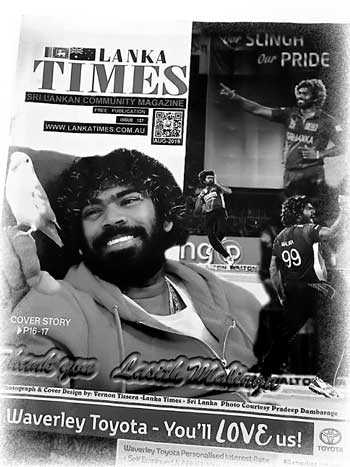Monday Mar 17, 2025
Monday Mar 17, 2025
Saturday, 28 September 2019 00:08 - - {{hitsCtrl.values.hits}}

 Fast bowler Lasith Malinga adorns the cover of the recent issue of ‘Lanka Times – Sri Lankan community magazine’ edited by Desmond Kelly. A double-page spread is devoted for Revatha S. Silva’s feature on Malinga along with photographs in colour.
Fast bowler Lasith Malinga adorns the cover of the recent issue of ‘Lanka Times – Sri Lankan community magazine’ edited by Desmond Kelly. A double-page spread is devoted for Revatha S. Silva’s feature on Malinga along with photographs in colour.
“As the sun set in Colombo’s western horizon on 26 July (2019) the R. Premadasa Stadium near Kettarama had been filled to its capacity. How electrifying a sight it was!” Revatha starts the narration, describing Lasith Malinga as “one of the last heroes Sri Lanka cricket has produced during its recent history”.
“Tens of thousands of spectators – chanting slogans, singing and dancing – have come on a working day to see one last hurrah of probably the most iconic and controversial cricketer of their generation. They’d come to celebrate the contribution of a once-ordinary ‘boy’ who rose, braving all challenges before him, to rule the world. It was proof that they had enjoyed, admired, and cherished Malinga’s game. They certainly have considered him a hero of the nation,” he writes.
He then discusses three ‘incredible features’ related to Malinga, who he recalls stormed in the 2007 World Cup in the Caribbean with a four-in-four against the Proteas.
 The first is ‘Identifying’ by Champaka Ramanayake, who paved the way for Malinga to the national team from downtrodden Ratgama down south.
The first is ‘Identifying’ by Champaka Ramanayake, who paved the way for Malinga to the national team from downtrodden Ratgama down south.
“Champika R. has said the leading Sri Lanka batsmen had refused to face the schoolboy Mali at the nets saying he was not a legitimate bowler. Mental agony created by similar refusals and humiliation has been part of his life. The fellow, therefore, has to be a celebrity simply for his sheer perseverance and constant self-belief.”
The second is ‘Uniqueness’ where Revatha describes how Malinga made batters’ heads virtually pan, left to right, when facing him. “There has never been such a ruthless slinger in the known history of the game. His bowling trajectory – which is not overtly ‘top to bottom’ but somewhat left to right – caused everyone rethink the whole batting technique. Even after fifteen years, with his speed reduced and reflexes slower, Malinga still remains a wicket-taker and chief destroyer in any game he plays. His pinpoint accuracy, especially in Yorkers, and his astute reading of situations are Malinga’s trademarks.
“He never depended only on his ‘advantageous’ bowling action. His relatively long life in international cricket was owing also his willingness to innovate, his focus, and determination; all great features for nay youngster to follow.”
The third is ‘The critique and overcoming it’. “Wherever he played, he made sure he is nonpareil. He won many titles in Mumbai Indians at the IPL. He set a new record at the Big Bash League in 2012 taking six for seven runs for Melbourne Stars. Once, when the authorities dumped him for injuries, he rose again like a phoenix. His body tattoos, eyebrow piercings and goldilocks were revolutionary in Sri Lanka cricket arena. Yet he overcame all opposing, traditionalist reproaches to emerge the darling of a generation, a modern-day role-model for youngsters, world over.”
“The packed Kettarama on that Friday was pure proof that Sri Lankans are really forgetting and forgiving. They had retained their love for this poster boy from Ratgama.”
Revatha concludes: “The omnipresent ‘Malinga wigs’ were spotted at the R. Premadasa that day like never before. As he took the last Bangladeshi wicket in his final ODI over and pointed his fingers towards that darkish Colombo night sky, the roar that we heard was simple amazing. A sporting outcast, an oddity, and a real rascal of our time, he gained his final recognition. His cause has been justified in the final frontier. ‘Mali, Mali, Mali…’ There will never be another one like you.”
Discover Kapruka, the leading online shopping platform in Sri Lanka, where you can conveniently send Gifts and Flowers to your loved ones for any event including Valentine ’s Day. Explore a wide range of popular Shopping Categories on Kapruka, including Toys, Groceries, Electronics, Birthday Cakes, Fruits, Chocolates, Flower Bouquets, Clothing, Watches, Lingerie, Gift Sets and Jewellery. Also if you’re interested in selling with Kapruka, Partner Central by Kapruka is the best solution to start with. Moreover, through Kapruka Global Shop, you can also enjoy the convenience of purchasing products from renowned platforms like Amazon and eBay and have them delivered to Sri Lanka.
Discover Kapruka, the leading online shopping platform in Sri Lanka, where you can conveniently send Gifts and Flowers to your loved ones for any event including Valentine ’s Day. Explore a wide range of popular Shopping Categories on Kapruka, including Toys, Groceries, Electronics, Birthday Cakes, Fruits, Chocolates, Flower Bouquets, Clothing, Watches, Lingerie, Gift Sets and Jewellery. Also if you’re interested in selling with Kapruka, Partner Central by Kapruka is the best solution to start with. Moreover, through Kapruka Global Shop, you can also enjoy the convenience of purchasing products from renowned platforms like Amazon and eBay and have them delivered to Sri Lanka.